TOYOTA GR86 2022 Owners Manual (in English)
Manufacturer: TOYOTA, Model Year: 2022, Model line: GR86, Model: TOYOTA GR86 2022Pages: 582, PDF Size: 86.38 MB
Page 131 of 582
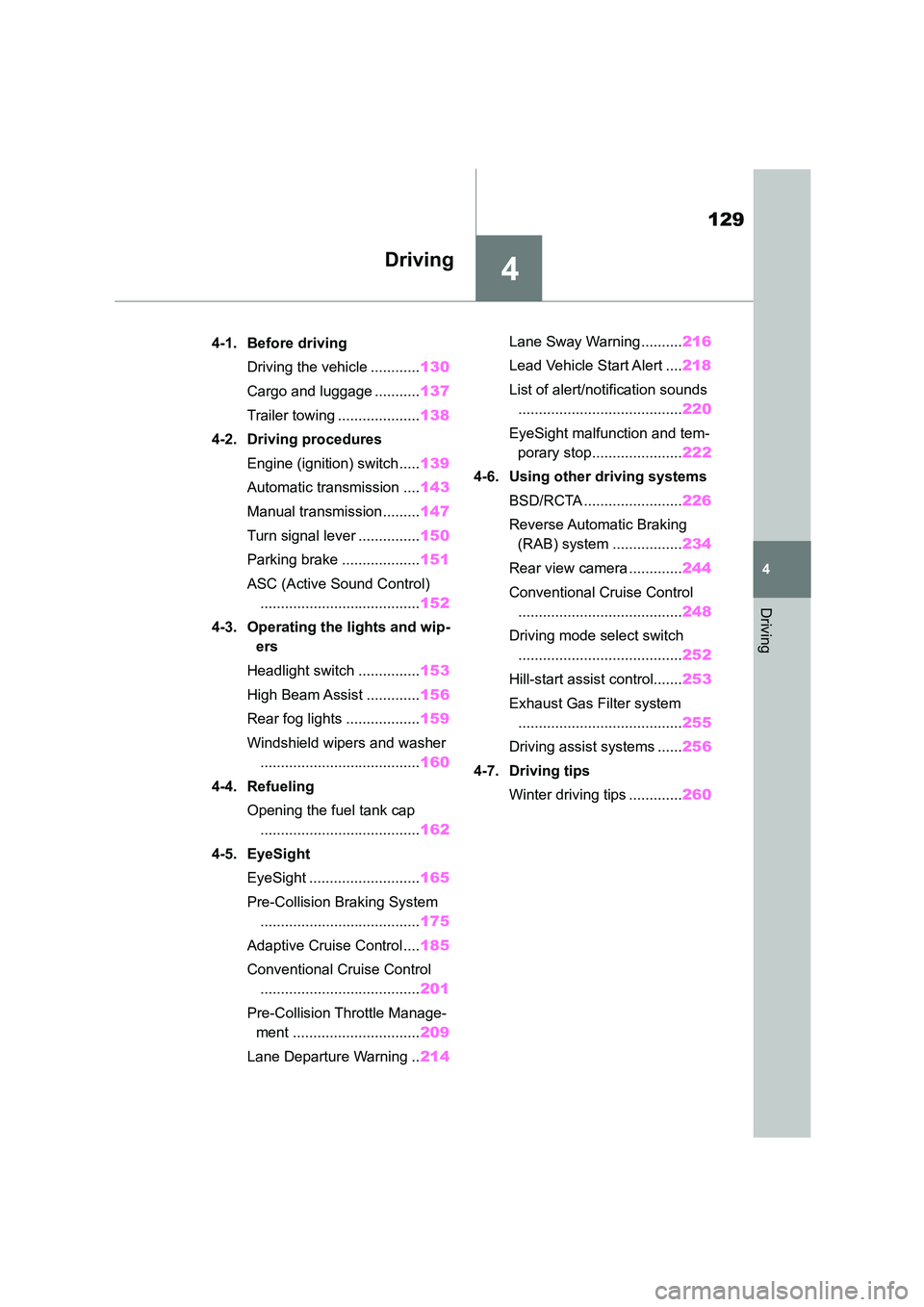
4
129
4
Driving
Driving
.4-1. Before driving
Driving the vehicle ............ 130
Cargo and luggage ........... 137
Trailer towing .................... 138
4-2. Driving procedures
Engine (ignition) switch ..... 139
Automatic transmission .... 143
Manual transmission ......... 147
Turn signal lever ............... 150
Parking brake ................... 151
ASC (Active Sound Control)
....................................... 152
4-3. Operating the lights and wip-
ers
Headlight switch ............... 153
High Beam Assist ............. 156
Rear fog lights .................. 159
Windshield wipers and washer
....................................... 160
4-4. Refueling
Opening the fuel tank cap
....................................... 162
4-5. EyeSight
EyeSight ........................... 165
Pre-Collision Braking System
....................................... 175
Adaptive Cruise Control.... 185
Conventional Cruise Control
....................................... 201
Pre-Collision Throttle Manage-
ment ............................... 209
Lane Departure Warning .. 214
Lane Sway Warning.......... 216
Lead Vehicle Start Alert .... 218
List of alert/notification sounds
........................................ 220
EyeSight malfunction and tem-
porary stop...................... 222
4-6. Using other driving systems
BSD/RCTA ........................ 226
Reverse Automatic Braking
(RAB) system ................. 234
Rear view camera ............. 244
Conventional Cruise Control
........................................ 248
Driving mode select switch
........................................ 252
Hill-start assist control....... 253
Exhaust Gas Filter system
........................................ 255
Driving assist systems ...... 256
4-7. Driving tips
Winter driving tips ............. 260
Page 132 of 582
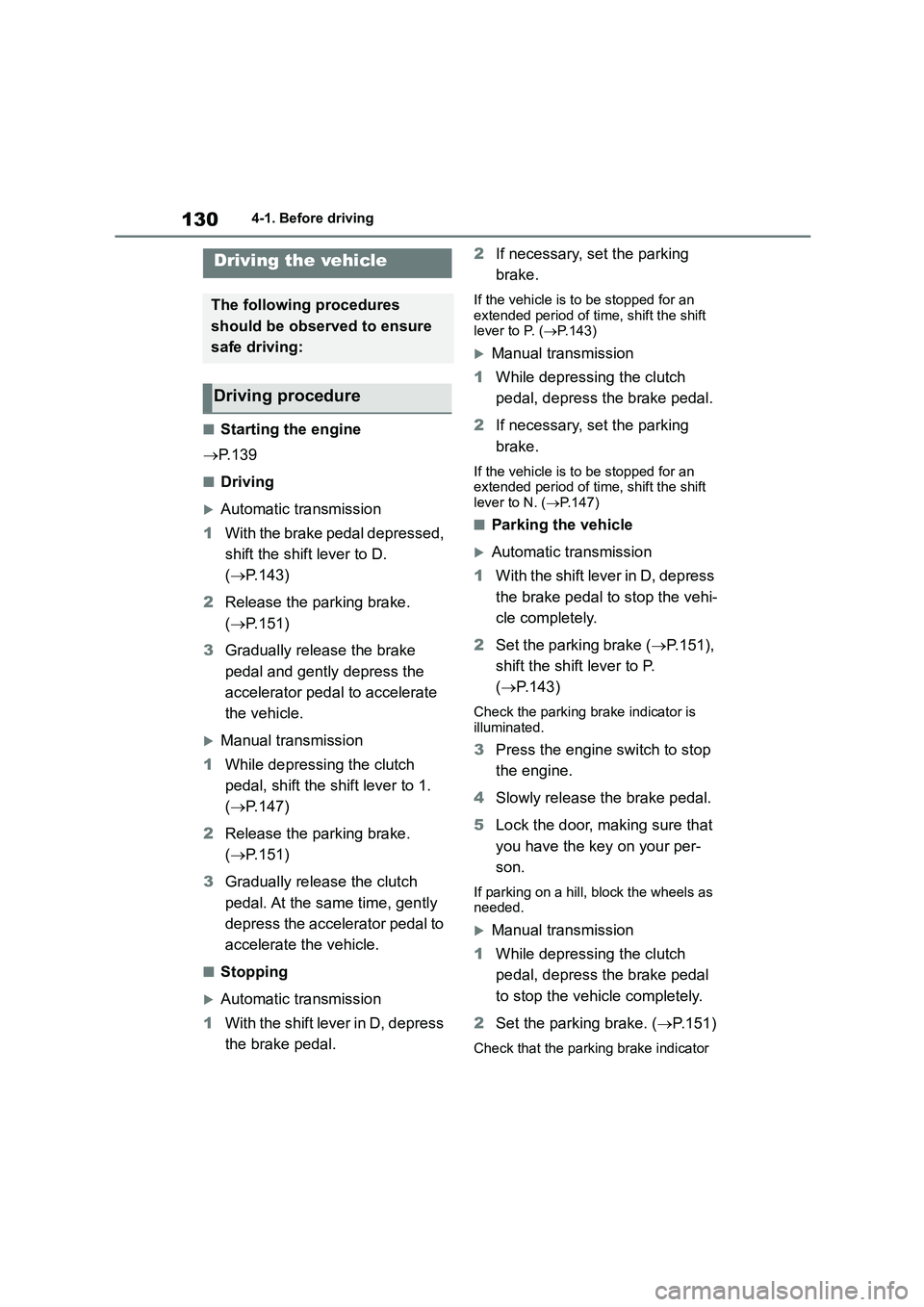
1304-1. Before driving
4-1.Before driving
■Starting the engine
P. 1 3 9
■Driving
Automatic transmission
1 With the brake pedal depressed,
shift the shift lever to D.
( P.143)
2 Release the parking brake.
( P.151)
3 Gradually release the brake
pedal and gently depress the
accelerator pedal to accelerate
the vehicle.
Manual transmission
1 While depressing the clutch
pedal, shift the shift lever to 1.
( P.147)
2 Release the parking brake.
( P.151)
3 Gradually release the clutch
pedal. At the same time, gently
depress the accelerator pedal to
accelerate the vehicle.
■Stopping
Automatic transmission
1 With the shift lever in D, depress
the brake pedal.
2 If necessary, set the parking
brake.
If the vehicle is to be stopped for an
extended period of time, shift the shift lever to P. ( P.143)
Manual transmission
1 While depressing the clutch
pedal, depress the brake pedal.
2 If necessary, set the parking
brake.
If the vehicle is to be stopped for an extended period of time, shift the shift
lever to N. ( P.147)
■Parking the vehicle
Automatic transmission
1 With the shift lever in D, depress
the brake pedal to stop the vehi-
cle completely.
2 Set the parking brake (P.151),
shift the shift lever to P.
( P.143)
Check the parking brake indicator is
illuminated.
3 Press the engine switch to stop
the engine.
4 Slowly release the brake pedal.
5 Lock the door, making sure that
you have the key on your per-
son.
If parking on a hill, block the wheels as
needed.
Manual transmission
1 While depressing the clutch
pedal, depress the brake pedal
to stop the vehicle completely.
2 Set the parking brake. (P.151)
Check that the parking brake indicator
Driving the vehicle
The following procedures
should be observed to ensure
safe driving:
Driving procedure
Page 133 of 582
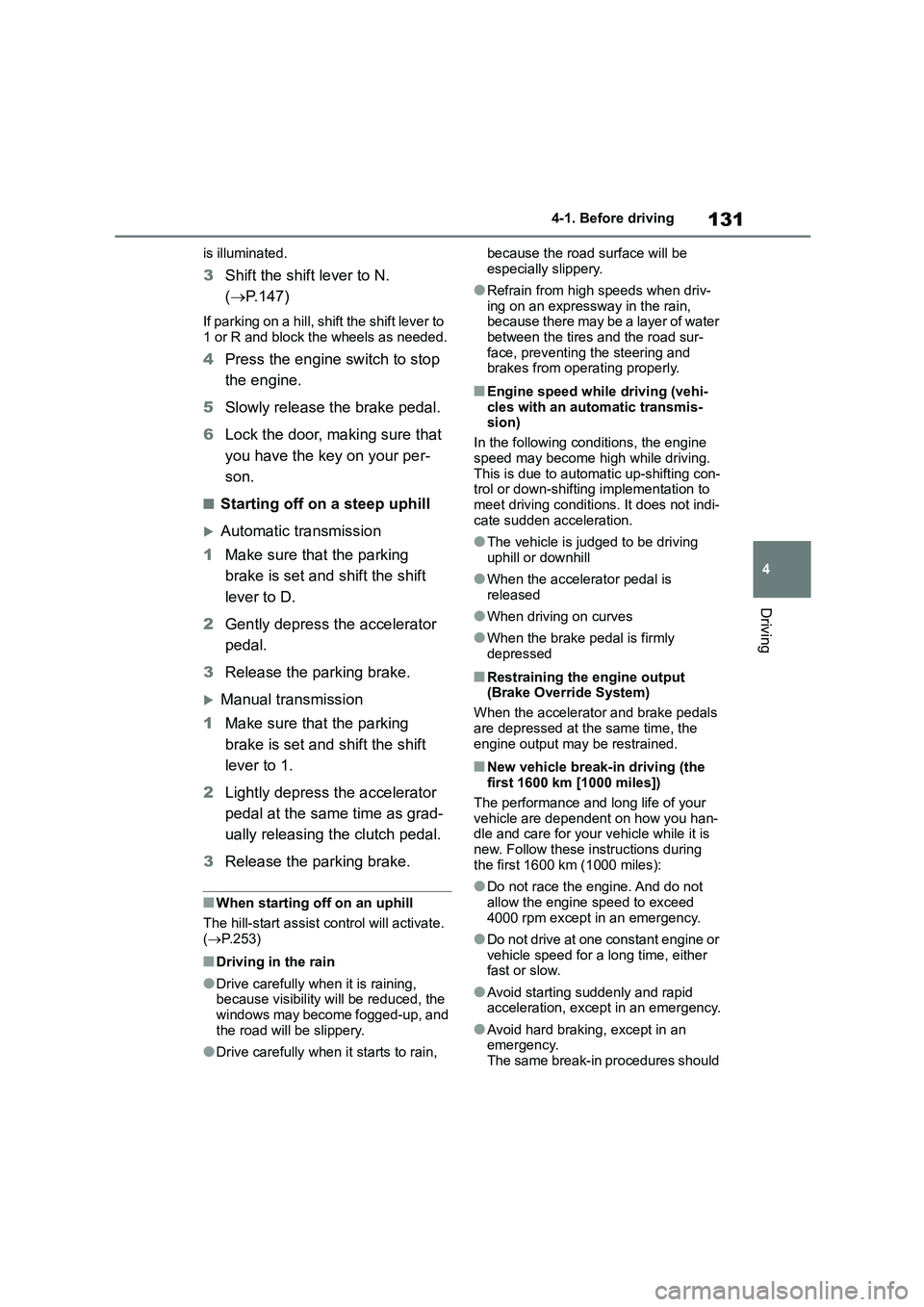
131
4
4-1. Before driving
Driving
is illuminated.
3 Shift the shift lever to N.
( P.147)
If parking on a hill, shift the shift lever to
1 or R and block the wheels as needed.
4 Press the engine switch to stop
the engine.
5 Slowly release the brake pedal.
6 Lock the door, making sure that
you have the key on your per-
son.
■Starting off on a steep uphill
Automatic transmission
1 Make sure that the parking
brake is set and shift the shift
lever to D.
2 Gently depress the accelerator
pedal.
3 Release the parking brake.
Manual transmission
1 Make sure that the parking
brake is set and shift the shift
lever to 1.
2 Lightly depress the accelerator
pedal at the same time as grad-
ually releasing the clutch pedal.
3 Release the parking brake.
■When starting off on an uphill
The hill-start assist c ontrol will activate.
( P.253)
■Driving in the rain
●Drive carefully when it is raining,
because visibility will be reduced, the windows may become fogged-up, and
the road will be slippery.
●Drive carefully when it starts to rain,
because the road surface will be
especially slippery.
●Refrain from high speeds when driv-
ing on an expressway in the rain, because there may be a layer of water
between the tires and the road sur-
face, preventing the steering and brakes from operating properly.
■Engine speed while driving (vehi-
cles with an automatic transmis-
sion)
In the following conditions, the engine
speed may become high while driving.
This is due to automatic up-shifting con- trol or down-shifting implementation to
meet driving conditions. It does not indi-
cate sudden acceleration.
●The vehicle is judged to be driving
uphill or downhill
●When the accelerator pedal is
released
●When driving on curves
●When the brake pedal is firmly
depressed
■Restraining the engine output
(Brake Override System)
When the accelerator and brake pedals
are depressed at the same time, the
engine output may be restrained.
■New vehicle break-in driving (the first 1600 km [1000 miles])
The performance and long life of your
vehicle are dependent on how you han- dle and care for your vehicle while it is
new. Follow these instructions during
the first 1600 km (1000 miles):
●Do not race the engine. And do not
allow the engine speed to exceed
4000 rpm except in an emergency.
●Do not drive at one constant engine or
vehicle speed for a long time, either fast or slow.
●Avoid starting suddenly and rapid acceleration, except in an emergency.
●Avoid hard braking, except in an emergency.
The same break-in procedures should
Page 134 of 582
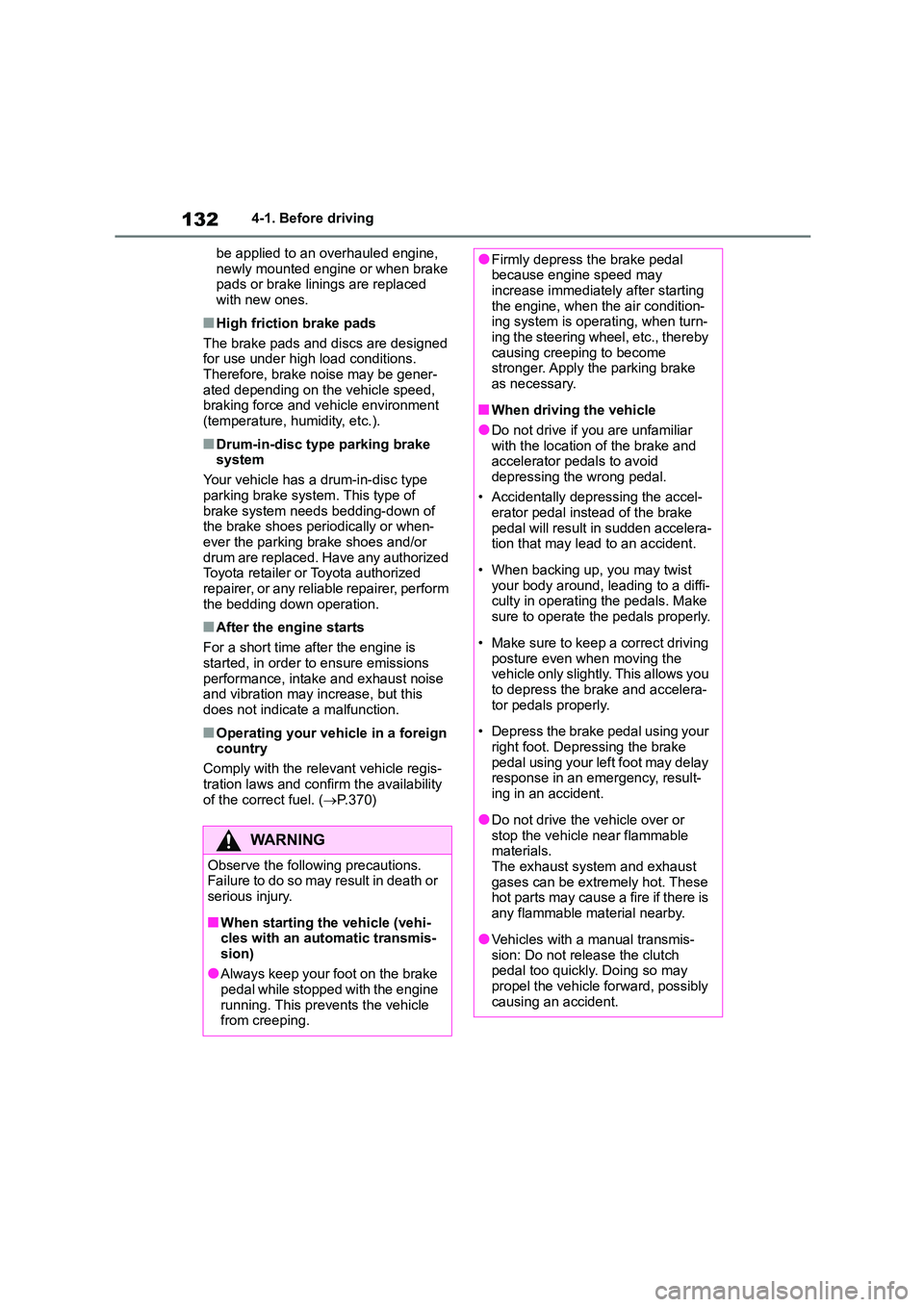
1324-1. Before driving
be applied to an overhauled engine,
newly mounted engine or when brake pads or brake linings are replaced
with new ones.
■High friction brake pads
The brake pads and discs are designed for use under high load conditions.
Therefore, brake noise may be gener-
ated depending on the vehicle speed, braking force and vehicle environment
(temperature, humidity, etc.).
■Drum-in-disc type parking brake
system
Your vehicle has a drum-in-disc type
parking brake system. This type of
brake system needs bedding-down of the brake shoes periodically or when-
ever the parking brake shoes and/or
drum are replaced. Have any authorized Toyota retailer or Toyota authorized
repairer, or any reliable repairer, perform
the bedding down operation.
■After the engine starts
For a short time after the engine is
started, in order to ensure emissions
performance, intake and exhaust noise and vibration may increase, but this
does not indicate a malfunction.
■Operating your vehicle in a foreign
country
Comply with the relevant vehicle regis-
tration laws and confirm the availability
of the correct fuel. ( P.370)
WA R N I N G
Observe the following precautions. Failure to do so may result in death or
serious injury.
■When starting the vehicle (vehi-
cles with an automatic transmis-
sion)
●Always keep your foot on the brake
pedal while stopped with the engine
running. This prevents the vehicle from creeping.
●Firmly depress the brake pedal because engine speed may
increase immediately after starting
the engine, when the air condition- ing system is operating, when turn-
ing the steering wheel, etc., thereby
causing creeping to become stronger. Apply the parking brake
as necessary.
■When driving the vehicle
●Do not drive if you are unfamiliar
with the location of the brake and accelerator pedals to avoid
depressing the wrong pedal.
• Accidentally depressing the accel- erator pedal instead of the brake
pedal will result in sudden accelera-
tion that may lead to an accident.
• When backing up, you may twist
your body around, leading to a diffi- culty in operating the pedals. Make
sure to operate the pedals properly.
• Make sure to keep a correct driving
posture even when moving the
vehicle only slightly. This allows you to depress the brake and accelera-
tor pedals properly.
• Depress the brake pedal using your
right foot. Depressing the brake
pedal using your left foot may delay response in an emergency, result-
ing in an accident.
●Do not drive the vehicle over or
stop the vehicle near flammable
materials. The exhaust system and exhaust
gases can be extremely hot. These
hot parts may cause a fire if there is any flammable material nearby.
●Vehicles with a manual transmis-
sion: Do not release the clutch pedal too quickly. Doing so may
propel the vehicle forward, possibly
causing an accident.
Page 135 of 582
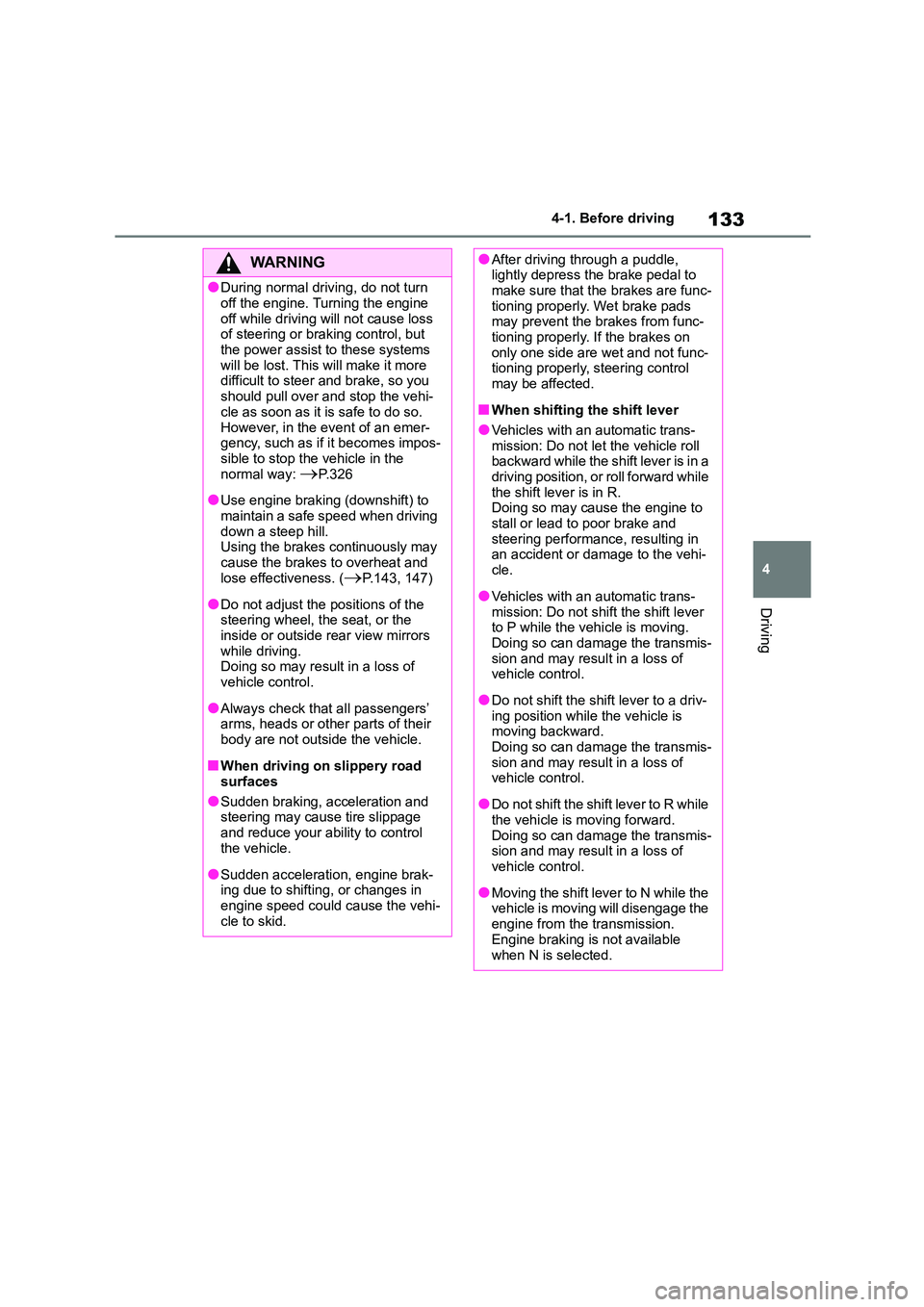
133
4
4-1. Before driving
Driving
WA R N I N G
●During normal driving, do not turn
off the engine. Turning the engine
off while driving will not cause loss of steering or braking control, but
the power assist to these systems
will be lost. This will make it more difficult to steer and brake, so you
should pull over and stop the vehi-
cle as soon as it is safe to do so.
However, in the event of an emer- gency, such as if it becomes impos-
sible to stop the vehicle in the
normal way: P. 3 2 6
●Use engine braking (downshift) to
maintain a safe speed when driving down a steep hill.
Using the brakes continuously may
cause the brakes to overheat and lose effectiveness. (P.143, 147)
●Do not adjust the positions of the steering wheel, the seat, or the
inside or outside rear view mirrors
while driving. Doing so may result in a loss of
vehicle control.
●Always check that all passengers’
arms, heads or other parts of their
body are not outside the vehicle.
■When driving on slippery road
surfaces
●Sudden braking, acceleration and
steering may cause tire slippage
and reduce your ability to control the vehicle.
●Sudden acceleration, engine brak-ing due to shifting, or changes in
engine speed could cause the vehi-
cle to skid.
●After driving through a puddle, lightly depress the brake pedal to
make sure that the brakes are func-
tioning properly. Wet brake pads may prevent the brakes from func-
tioning properly. If the brakes on
only one side are wet and not func- tioning properly, steering control
may be affected.
■When shifting the shift lever
●Vehicles with an automatic trans-
mission: Do not let the vehicle roll backward while the sh ift lever is in a
driving position, or roll forward while
the shift lever is in R. Doing so may cause the engine to
stall or lead to poor brake and
steering performance, resulting in an accident or damage to the vehi-
cle.
●Vehicles with an automatic trans-
mission: Do not shi ft the shift lever
to P while the vehicle is moving. Doing so can damage the transmis-
sion and may result in a loss of
vehicle control.
●Do not shift the shift lever to a driv-
ing position while the vehicle is moving backward.
Doing so can damage the transmis-
sion and may result in a loss of vehicle control.
●Do not shift the shift lever to R while the vehicle is moving forward.
Doing so can damage the transmis-
sion and may result in a loss of vehicle control.
●Moving the shift lever to N while the vehicle is moving will disengage the
engine from the transmission.
Engine braking is not available
when N is selected.
Page 136 of 582
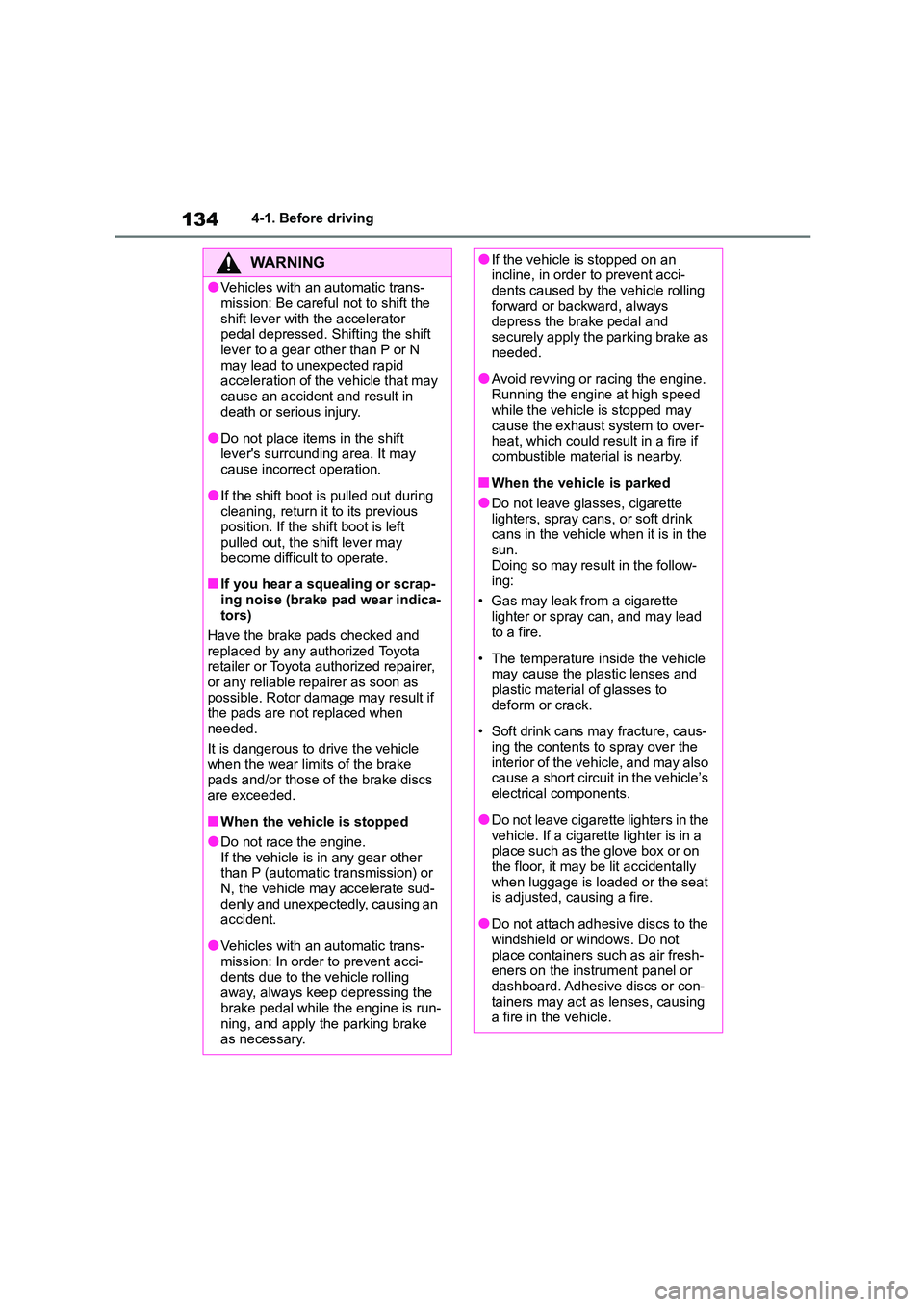
1344-1. Before driving
WA R N I N G
●Vehicles with an automatic trans-
mission: Be careful not to shift the
shift lever with the accelerator pedal depressed. Shifting the shift
lever to a gear other than P or N
may lead to unexpected rapid acceleration of the vehicle that may
cause an accident and result in
death or serious injury.
●Do not place items in the shift
lever's surrounding area. It may
cause incorrect operation.
●If the shift boot is pulled out during
cleaning, return it to its previous position. If the shift boot is left
pulled out, the shift lever may
become difficult to operate.
■If you hear a squealing or scrap-
ing noise (brake pad wear indica- tors)
Have the brake pads checked and
replaced by any authorized Toyota retailer or Toyota authorized repairer,
or any reliable repairer as soon as
possible. Rotor damage may result if the pads are not replaced when
needed.
It is dangerous to drive the vehicle when the wear limits of the brake
pads and/or those of the brake discs
are exceeded.
■When the vehicle is stopped
●Do not race the engine. If the vehicle is in any gear other
than P (automatic transmission) or
N, the vehicle may accelerate sud- denly and unexpectedly, causing an
accident.
●Vehicles with an automatic trans-
mission: In order to prevent acci-
dents due to the vehicle rolling away, always keep depressing the
brake pedal while the engine is run-
ning, and apply the parking brake as necessary.
●If the vehicle is stopped on an incline, in order to prevent acci-
dents caused by the vehicle rolling
forward or backward, always depress the brake pedal and
securely apply the parking brake as
needed.
●Avoid revving or racing the engine.
Running the engine at high speed while the vehicle is stopped may
cause the exhaust system to over-
heat, which could result in a fire if combustible material is nearby.
■When the vehicle is parked
●Do not leave glasses, cigarette
lighters, spray cans, or soft drink
cans in the vehicle when it is in the sun.
Doing so may result in the follow-
ing:
• Gas may leak from a cigarette
lighter or spray can, and may lead
to a fire.
• The temperature inside the vehicle
may cause the plastic lenses and plastic material of glasses to
deform or crack.
• Soft drink cans may fracture, caus-
ing the contents to spray over the
interior of the vehicle, and may also cause a short circuit in the vehicle’s
electrical components.
●Do not leave cigarette lighters in the
vehicle. If a cigarette lighter is in a
place such as the glove box or on the floor, it may be lit accidentally
when luggage is loaded or the seat
is adjusted, causing a fire.
●Do not attach adh esive discs to the
windshield or windows. Do not
place containers such as air fresh- eners on the instrument panel or
dashboard. Adhesive discs or con-
tainers may act as lenses, causing a fire in the vehicle.
Page 137 of 582
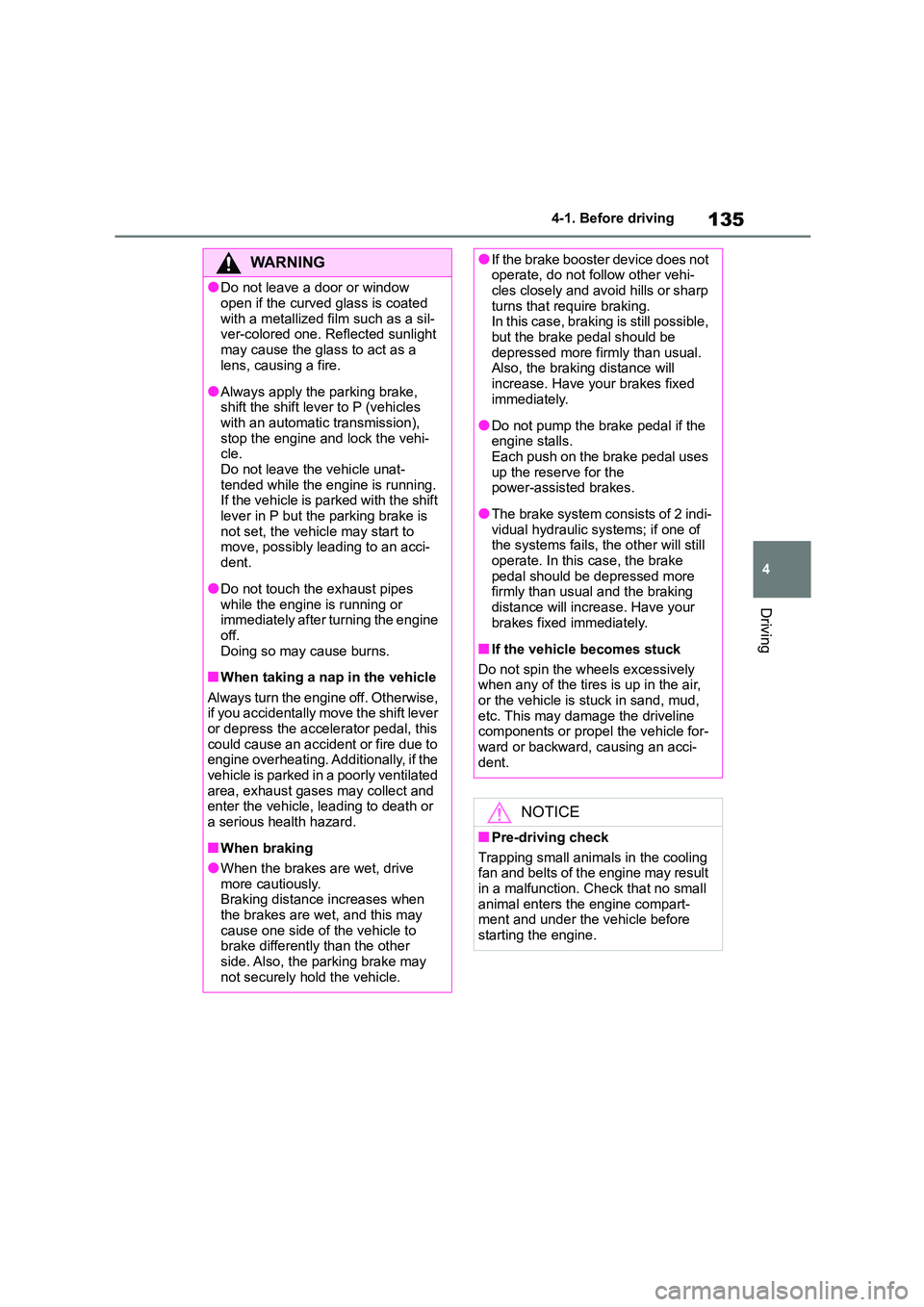
135
4
4-1. Before driving
Driving
WA R N I N G
●Do not leave a door or window
open if the curved glass is coated
with a metallized film such as a sil- ver-colored one. Reflected sunlight
may cause the glass to act as a
lens, causing a fire.
●Always apply the parking brake,
shift the shift lever to P (vehicles
with an automatic transmission), stop the engine and lock the vehi-
cle.
Do not leave the vehicle unat- tended while the engine is running.
If the vehicle is parked with the shift
lever in P but the parking brake is not set, the vehicl e may start to
move, possibly leading to an acci-
dent.
●Do not touch the exhaust pipes
while the engine is running or immediately after turning the engine
off.
Doing so may cause burns.
■When taking a nap in the vehicle
Always turn the engine off. Otherwise, if you accidentally move the shift lever
or depress the accelerator pedal, this
could cause an accident or fire due to engine overheating. Additionally, if the
vehicle is parked in a poorly ventilated
area, exhaust gases may collect and enter the vehicle, leading to death or
a serious health hazard.
■When braking
●When the brakes are wet, drive
more cautiously. Braking distance increases when
the brakes are wet, and this may
cause one side of the vehicle to brake differently than the other
side. Also, the parking brake may
not securely hold the vehicle.
●If the brake booster device does not operate, do not follow other vehi-
cles closely and avoid hills or sharp
turns that require braking. In this case, braking is still possible,
but the brake pedal should be
depressed more firmly than usual. Also, the braking distance will
increase. Have your brakes fixed
immediately.
●Do not pump the brake pedal if the
engine stalls. Each push on the brake pedal uses
up the reserve for the
power-assisted brakes.
●The brake system consists of 2 indi-
vidual hydraulic systems; if one of the systems fails, the other will still
operate. In this case, the brake
pedal should be depressed more firmly than usual and the braking
distance will increase. Have your
brakes fixed immediately.
■If the vehicle becomes stuck
Do not spin the wheels excessively when any of the tires is up in the air,
or the vehicle is stuck in sand, mud,
etc. This may damage the driveline components or propel the vehicle for-
ward or backward, causing an acci-
dent.
NOTICE
■Pre-driving check
Trapping small animals in the cooling
fan and belts of the engine may result
in a malfunction. Check that no small animal enters the engine compart-
ment and under the vehicle before
starting the engine.
Page 138 of 582
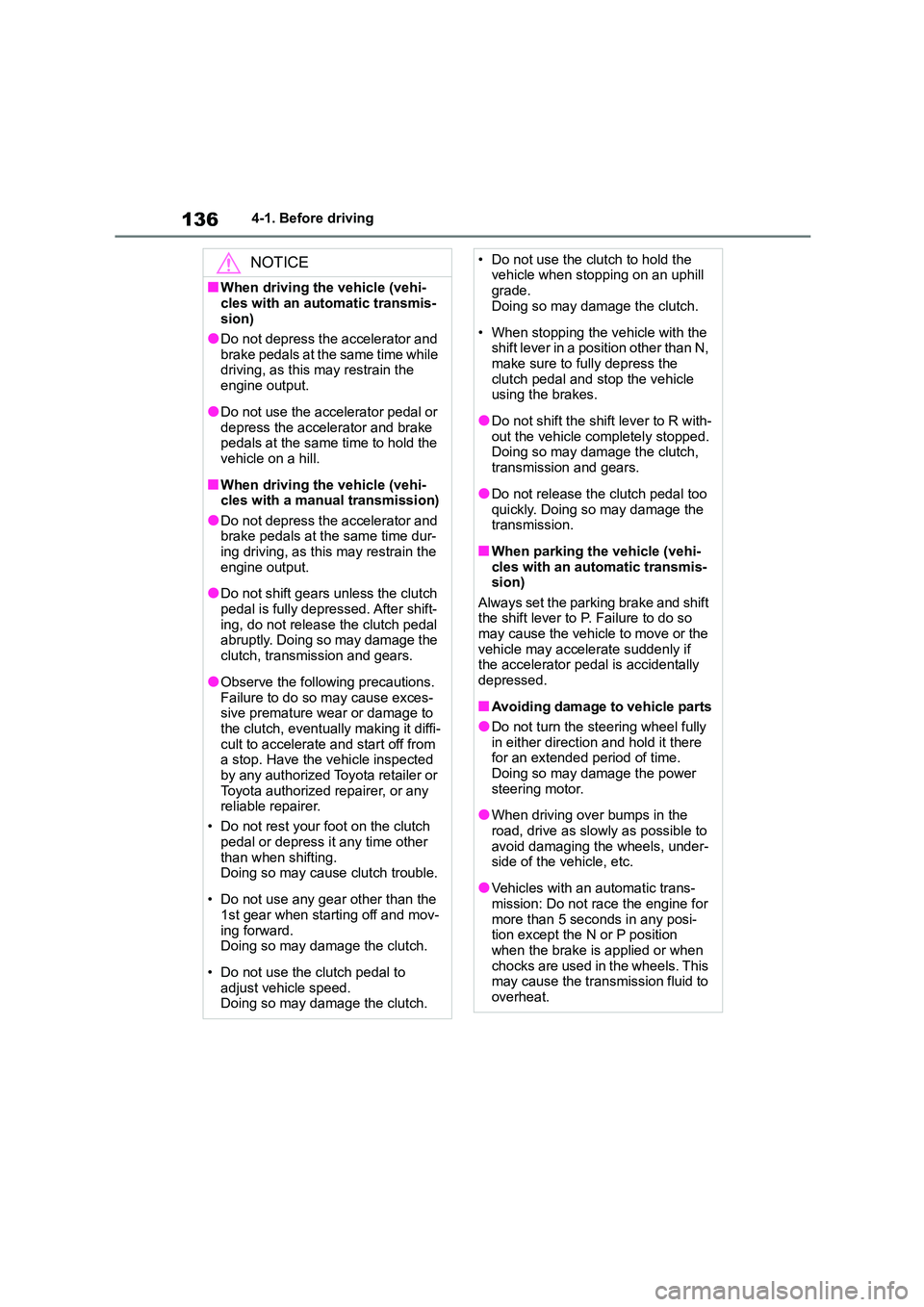
1364-1. Before driving
NOTICE
■When driving the vehicle (vehi-
cles with an automatic transmis-
sion)
●Do not depress the accelerator and
brake pedals at the same time while
driving, as this may restrain the engine output.
●Do not use the accelerator pedal or
depress the accelerator and brake pedals at the same time to hold the
vehicle on a hill.
■When driving the vehicle (vehi-
cles with a manual transmission)
●Do not depress the accelerator and brake pedals at the same time dur-
ing driving, as this may restrain the
engine output.
●Do not shift gears unless the clutch
pedal is fully depressed. After shift- ing, do not release the clutch pedal
abruptly. Doing so may damage the
clutch, transmission and gears.
●Observe the following precautions.
Failure to do so may cause exces- sive premature wear or damage to
the clutch, eventually making it diffi-
cult to accelerate and start off from a stop. Have the vehicle inspected
by any authorized Toyota retailer or
Toyota authorized repairer, or any reliable repairer.
• Do not rest your foot on the clutch
pedal or depress it any time other than when shifting.
Doing so may cause clutch trouble.
• Do not use any gear other than the
1st gear when starting off and mov-
ing forward. Doing so may damage the clutch.
• Do not use the clutch pedal to adjust vehicle speed.
Doing so may damage the clutch.
• Do not use the clutch to hold the vehicle when stopping on an uphill
grade.
Doing so may damage the clutch.
• When stopping the vehicle with the
shift lever in a position other than N, make sure to fully depress the
clutch pedal and stop the vehicle
using the brakes.
●Do not shift the shift lever to R with-
out the vehicle completely stopped. Doing so may damage the clutch,
transmission and gears.
●Do not release the clutch pedal too
quickly. Doing so may damage the
transmission.
■When parking the vehicle (vehi-
cles with an automatic transmis- sion)
Always set the parking brake and shift
the shift lever to P. Failure to do so may cause the vehicl e to move or the
vehicle may accelerate suddenly if
the accelerator pedal is accidentally depressed.
■Avoiding damage to vehicle parts
●Do not turn the steering wheel fully
in either direction and hold it there
for an extended period of time. Doing so may damage the power
steering motor.
●When driving over bumps in the
road, drive as slowly as possible to
avoid damaging the wheels, under- side of the vehicle, etc.
●Vehicles with an automatic trans-mission: Do not race the engine for
more than 5 seconds in any posi-
tion except the N or P position
when the brake is applied or when chocks are used in the wheels. This
may cause the transmission fluid to
overheat.
Page 139 of 582
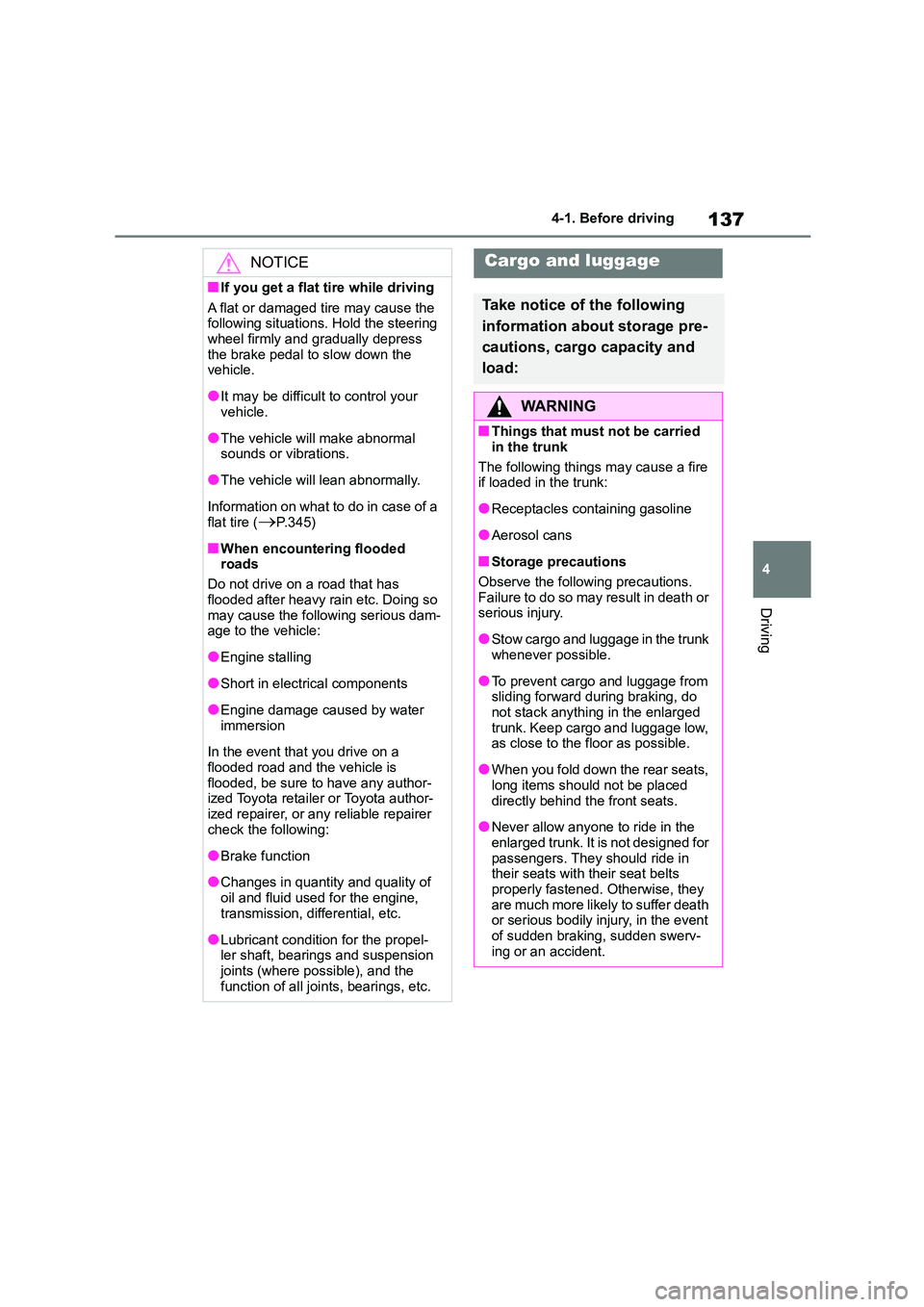
137
4
4-1. Before driving
Driving
NOTICE
■If you get a flat tire while driving
A flat or damaged tire may cause the
following situations. Hold the steering wheel firmly and gradually depress
the brake pedal to slow down the
vehicle.
●It may be difficult to control your
vehicle.
●The vehicle will make abnormal
sounds or vibrations.
●The vehicle will lean abnormally.
Information on what to do in case of a flat tire (P.345)
■When encountering flooded roads
Do not drive on a road that has
flooded after heavy rain etc. Doing so may cause the following serious dam-
age to the vehicle:
●Engine stalling
●Short in electrical components
●Engine damage caused by water
immersion
In the event that you drive on a
flooded road and the vehicle is flooded, be sure to have any author-
ized Toyota retailer or Toyota author-
ized repairer, or any reliable repairer check the following:
●Brake function
●Changes in quantity and quality of
oil and fluid used for the engine, transmission, differential, etc.
●Lubricant condition for the propel-ler shaft, bearings and suspension
joints (where possible), and the
function of all joints, bearings, etc.
Cargo and luggage
Take notice of the following
information about storage pre-
cautions, cargo capacity and
load:
WA R N I N G
■Things that must not be carried
in the trunk
The following things may cause a fire if loaded in the trunk:
●Receptacles containing gasoline
●Aerosol cans
■Storage precautions
Observe the following precautions.
Failure to do so may result in death or serious injury.
●Stow cargo and luggage in the trunk whenever possible.
●To prevent cargo and luggage from sliding forward during braking, do
not stack anything in the enlarged
trunk. Keep cargo and luggage low, as close to the floor as possible.
●When you fold down the rear seats, long items should not be placed
directly behind the front seats.
●Never allow anyone to ride in the
enlarged trunk. It is not designed for
passengers. They should ride in their seats with their seat belts
properly fastened. Otherwise, they
are much more likely to suffer death or serious bodily injury, in the event
of sudden braking, sudden swerv-
ing or an accident.
Page 140 of 582
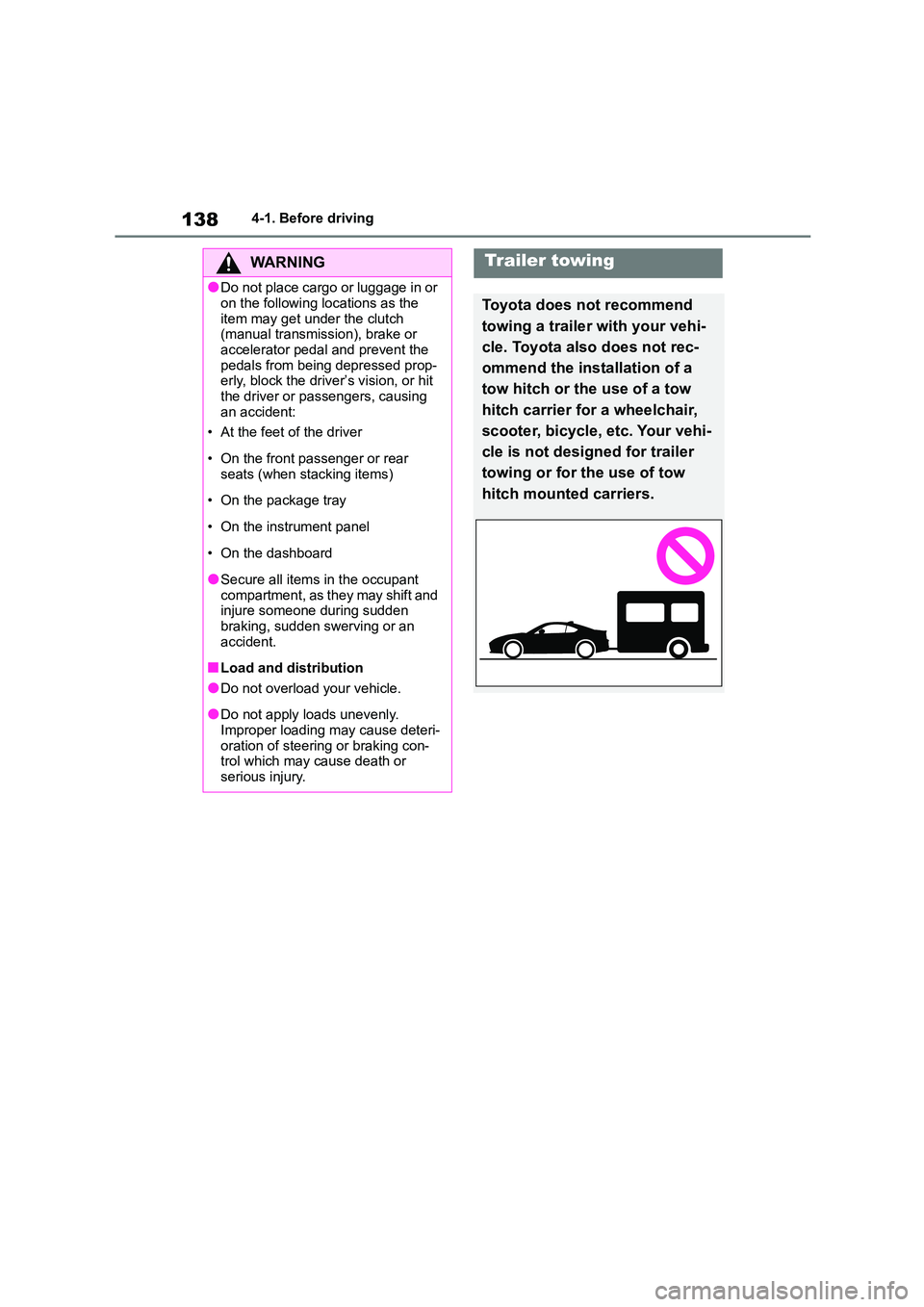
1384-1. Before driving
WA R N I N G
●Do not place cargo or luggage in or
on the following locations as the
item may get under the clutch (manual transmission), brake or
accelerator pedal and prevent the
pedals from being depressed prop- erly, block the driver’s vision, or hit
the driver or passengers, causing
an accident:
• At the feet of the driver
• On the front passenger or rear
seats (when stacking items)
• On the package tray
• On the instrument panel
• On the dashboard
●Secure all items in the occupant
compartment, as they may shift and injure someone during sudden
braking, sudden swerving or an
accident.
■Load and distribution
●Do not overload your vehicle.
●Do not apply loads unevenly.
Improper loading may cause deteri- oration of steering or braking con-
trol which may cause death or
serious injury.
Trailer towing
Toyota does not recommend
towing a trailer with your vehi-
cle. Toyota also does not rec-
ommend the installation of a
tow hitch or the use of a tow
hitch carrier for a wheelchair,
scooter, bicycle, etc. Your vehi-
cle is not designed for trailer
towing or for the use of tow
hitch mounted carriers.